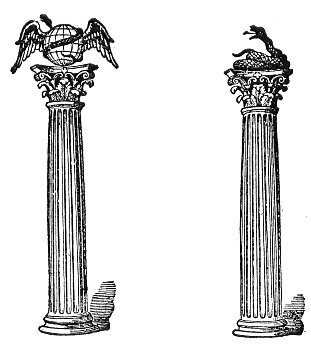p. 504
In ancient times the mark Tau was set on those who had been acquitted by their judges, as a symbol of innocence. The military commanders placed it on soldiers who escaped unhurt from the field of battle, as a sign of their safety under the Divine Protection.
It was a sacred symbol among the Druids. Divesting a tree of part of its branches, they left it in the shape of a Tau Cross, preserved it carefully, and consecrated it with solemn ceremonies. On the tree they cut deeply the word THAU, by which they meant God. On the right arm of the Cross, they inscribed the word HESULS, on the left BELEN or BELENUS, and on the middle of the trunk THARAMIS. This represented the sacred Triad.
It is certain that the Indians, Egyptians, and Arabians paid veneration to the sign of the Cross, thousands of years before the coming of Christ. Everywhere it was a sacred symbol. The Hindus and the Celtic Druids built many of their Temples in the form of a Cross, as the ruins still remaining clearly show, and particularly the ancient Druidical Temple at Classerniss in the Island of Lewis in Scotland. The Circle is of 12 Stones. On each of the sides, east, west, and south, are three. In the centre was the image of the Deity; and on the north an avenue of twice nineteen stones, and one at the entrance. The Supernal Pagoda at Benares is in the form of a Cross; and the Druidical subterranean grotto at New Grange in Ireland.
The Statue of Osiris at Rome had the same emblem. Isis and Ceres also bore it; and the caverns of initiation were constructed in that shape with a pyramid over the Sacellum.
Crosses were cut in the stones of the Temple of Serapis in Alexandria; and many Tau Crosses are to be seen in the sculptures of Alabastion and Esné, in Egypt. On coins, the symbol of the Egyptian God Kneph was a Cross within a Circle.
The Crux Ansata was the particular emblem of Osiris, and his sceptre ended with that figure. It was also the emblem of Hermes, and was considered a Sublime Hieroglyphic, possessing mysterious powers and virtues, as a wonder-working amulet.
The Sacred Tau occurs in the hands of the mummy-shaped figures between the forelegs of the row of Sphynxes, in the great avenue leading from Luxor to Karnac. By the Tau Cross the
p. 505
[paragraph continues] Cabalists expressed the number 10, a perfect number, denoting Heaven, and the Pythagorean Tetractys, or incommunicable name of God. The Taft Cross is also found on the stones in front of the door of the Temple of Amunoth III, at Thebes, who reigned about the time when the Israelites took possession of Canaan: and the Egyptian Priests carried it in all the sacred processions.
Tertullian, who had been initiated, informs us that the Tau was inscribed on the forehead of every person who had been admitted into the Mysteries of Mithras.
As the simple Tau represented Life, so, when the Circle, symbol of Eternity, was added, it represented Eternal Life.
At the Initiation of a King, the Tau, as the emblem of life and key of the Mysteries, was impressed upon his lips.
In the Indian Mysteries, the Tau Cross, under the name of Tiluk, was marked upon the body of the candidate, as a sign that he was set apart for the Sacred Mysteries.
On the upright tablet of the King, discovered at Nimroud, are the names of thirteen Great Gods (among which are YAV and BEL); and the left-hand character of every one is a cross composed of two cuneiform characters.
The Cross appears upon an Ancient Phœnician medal found in the ruins of Citium; on the very ancient Buddhist Obelisk near Ferns in Ross-shire; on the Buddhist Round Towers in Ireland, and upon the splendid obelisk of the same era at Forres in Scot-land.
Upon the facade of a temple at Kalabche in Nubia are three regal figures, each holding a Crux Ansata.
Like the Subterranean Mithriatic Temple at New Grange in Scotland, the Pagodas of Benares and Mathura were in the form of a Cross. Magnificent Buddhist Crosses were erected, and are still standing, at Clonmacnoise, Finglas, and Kilcullen in Ireland. Wherever the monuments of Buddhism are found, in India, Ceylon, or Ireland, we find the Cross: for Buddha or Boudh was represented to have been crucified.

Moe is the founder of GnosticWarrior.com. He is a father, husband, author, martial arts black belt, and an expert in Gnosticism, the occult, and esotericism.





